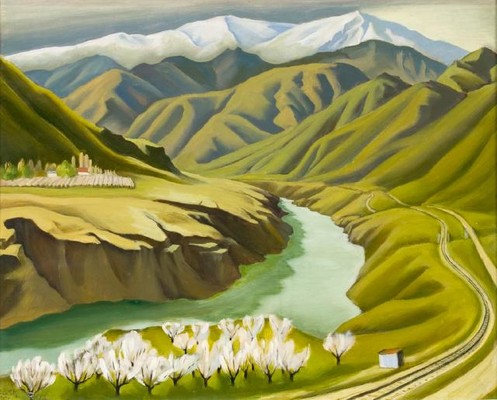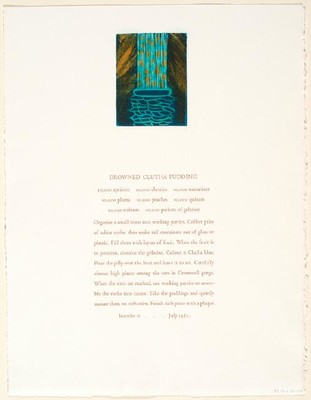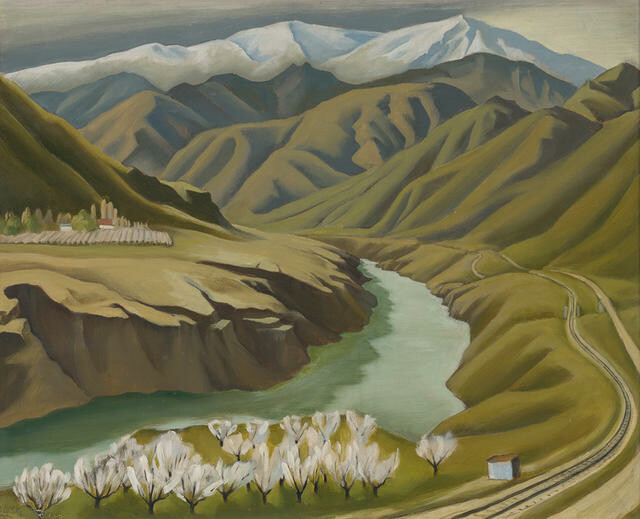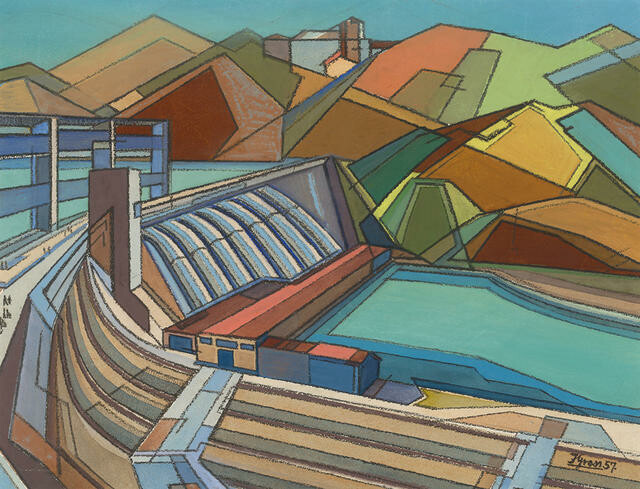B.
Clutha
Behind the scenes
Making the trip between Queenstown and Alexandra recently I was struck, as always, by the sight of the massive Clyde Dam.

Doris Lusk Untitled (Cromwell Gorge) 1950. Oil on gesso on hardboard. William Lorenzo Cox bequest, 2008
New Zealand's third largest hydroelectric dam, it was constructed on New Zealand's largest river, the mighty Clutha, between 1982 and 1993. The project, which became one of Prime Minister Robert Muldoon's so-called 'Think Big' schemes, was controversial, not least because it necessitated the flooding of the town of Cromwell (which was partially relocated to higher ground), the many fruit orchards that surrounded it and the magnificent Cromwell Gorge, seen in the 1950 painting above by Doris Lusk.

Marilynn Webb Drowned Clutha Pudding 1982. Monotype. Purchased 1983
Reproduced courtesy of Marilynn Webb ONZM
Printmaker Marilyn Webb was one of several artists to lend her voice to the anti-dam movement and she produced this monotype - Drowned Clutha Pudding - in 1982. The text reads:
Drowned Clutha Pudding
10,000 apricots 10,000 cherries 10,000 nectarines
10,000 plums 10,000 peaches 10,000 quinces
10,000 walnuts 10,000 packets of gelatine
Organize a small town into working parties. Collect piles of schist rocks, then make tall containers out of glass or plastic. Fill them with layers of fruit. When the fruit is in position, dissolve the gelatine. Colour it Clutha blue. Pour the jelly over the fruit and leave it to set. Carefully choose high places among the tors in Cromwell gorge. When the sites are marked, use working parties to assemble the rocks into cairns. Take the puddings and quietly mount them on each cairn. Finish each piece with a plaque.
Inscribe it . . . July 1982.

Frank Gross Tamed River 1957. Gouache and pastel. Donated from the Canterbury Public Library Collection, 2001. Reproduced with permission.
Prior to the Clyde dam project, the Clutha had previously been interrupted by the smaller Roxburgh dam, which is the subject of this 1957 work by Frank Gross.

Doris Lusk Study Of The Bridge, Clutha River 1985. Watercolour. Presented by the Friends of the McDougall Gallery, 1986. Reproduced with permission
The dam was filled in four stages between 1992 and 1993, creating Lake Dunstan, which also flooded the historic bridge that overlooked the confluence of the Clutha and Kawarau rivers, famous for the distinct colour difference between the two bodies of water. I can never look at the new lake without picturing the bridge (captured here in a 1985 study by Doris Lusk) and the thousands of fruit trees that lie deep beneath the waters.


